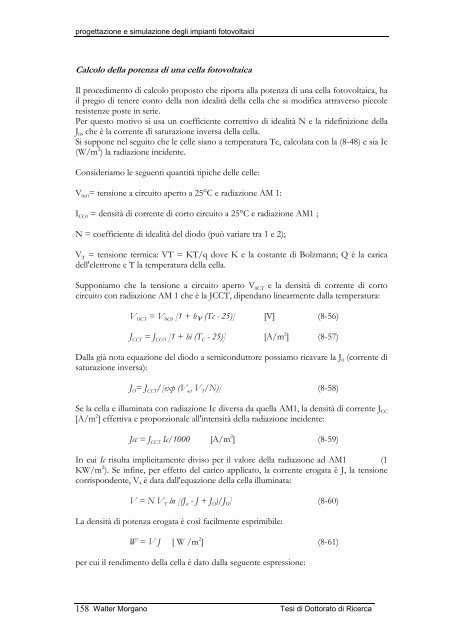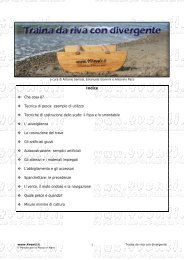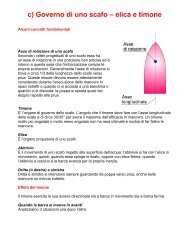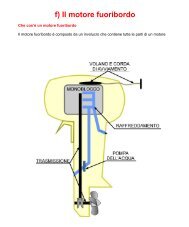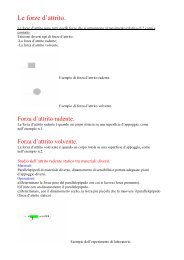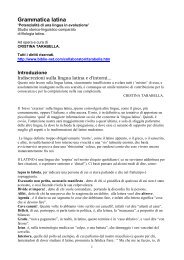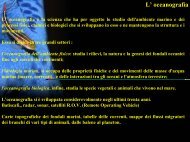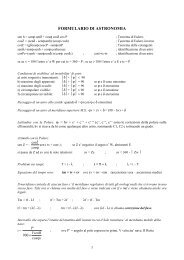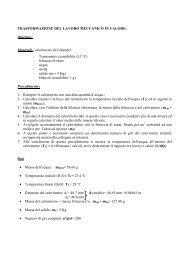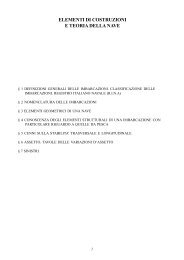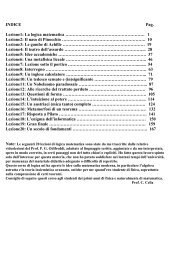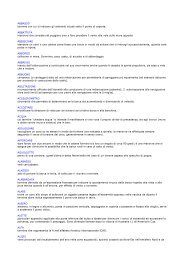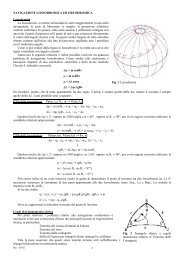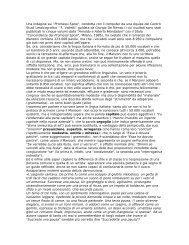produzione di energia elettrica con sistemi a celle ... - Il Saturatore
produzione di energia elettrica con sistemi a celle ... - Il Saturatore
produzione di energia elettrica con sistemi a celle ... - Il Saturatore
Create successful ePaper yourself
Turn your PDF publications into a flip-book with our unique Google optimized e-Paper software.
progettazione e simulazione degli impianti fotovoltaici<br />
Calcolo della potenza <strong>di</strong> una cella fotovoltaica<br />
<strong>Il</strong> proce<strong>di</strong>mento <strong>di</strong> calcolo proposto che riporta alla potenza <strong>di</strong> una cella fotovoltaica, ha<br />
il pregio <strong>di</strong> tenere <strong>con</strong>to della non idealità della cella che si mo<strong>di</strong>fica attraverso piccole<br />
resistenze poste in serie.<br />
Per questo motivo si usa un coefficiente correttivo <strong>di</strong> idealità N e la ridefinizione della<br />
J 0, che è la corrente <strong>di</strong> saturazione inversa della cella.<br />
Si suppone nel seguito che le <strong>celle</strong> siano a temperatura Tc, calcolata <strong>con</strong> la (8-48) e sia Ic<br />
(W/m 2 ) la ra<strong>di</strong>azione incidente.<br />
Consideriamo le seguenti quantità tipiche delle <strong>celle</strong>:<br />
V 0c0= tensione a circuito aperto a 25°C e ra<strong>di</strong>azione AM 1:<br />
I CC0 = densità <strong>di</strong> corrente <strong>di</strong> corto circuito a 25°C e ra<strong>di</strong>azione AM1 ;<br />
N = coefficiente <strong>di</strong> idealità del <strong>di</strong>odo (può variare tra 1 e 2);<br />
V T = tensione termica: VT = KT/q dove K e la costante <strong>di</strong> Bolzmann; Q è la carica<br />
dell'elettrone e T la temperatura della cella.<br />
Supponiamo che la tensione a circuito aperto V 0CT e la densità <strong>di</strong> corrente <strong>di</strong> corto<br />
circuito <strong>con</strong> ra<strong>di</strong>azione AM 1 che è la JCCT, <strong>di</strong>pendano linearmente dalla temperatura:<br />
158<br />
V OCT = V 0C0 [1 + hν (Tc - 25)] [V] (8-56)<br />
J CCT = J CCO [1 + hi (T C - 25)] [A/m 2 ] (8-57)<br />
Dalla già nota equazione del <strong>di</strong>odo a semi<strong>con</strong>duttore possiamo ricavare la J 0 (corrente <strong>di</strong><br />
saturazione inversa):<br />
J O= J CCT/[exp (V oct V T/N)] (8-58)<br />
Se la cella e illuminata <strong>con</strong> ra<strong>di</strong>azione Ic <strong>di</strong>versa da quella AM1, la densità <strong>di</strong> corrente J CC<br />
[A/m 2 ] effettiva e proporzionale all'intensità della ra<strong>di</strong>azione incidente:<br />
Jcc = J CCT Ic/1000 [A/m 2 ] (8-59)<br />
In cui Ic risulta implicitamente <strong>di</strong>viso per il valore della ra<strong>di</strong>azione ad AM1 (1<br />
KW/m 2 ). Se infine, per effetto del carico applicato, la corrente erogata è J, la tensione<br />
corrispondente, V, è data dall'equazione della cella illuminata:<br />
V = N V T ln [(J cc - J + J O)/J O] (8-60)<br />
La densità <strong>di</strong> potenza erogata è così facilmente esprimibile:<br />
W = V J [ W /m 2 ] (8-61)<br />
per cui il ren<strong>di</strong>mento della cella è dato dalla seguente espressione:<br />
Walter Morgano Tesi <strong>di</strong> Dottorato <strong>di</strong> Ricerca


